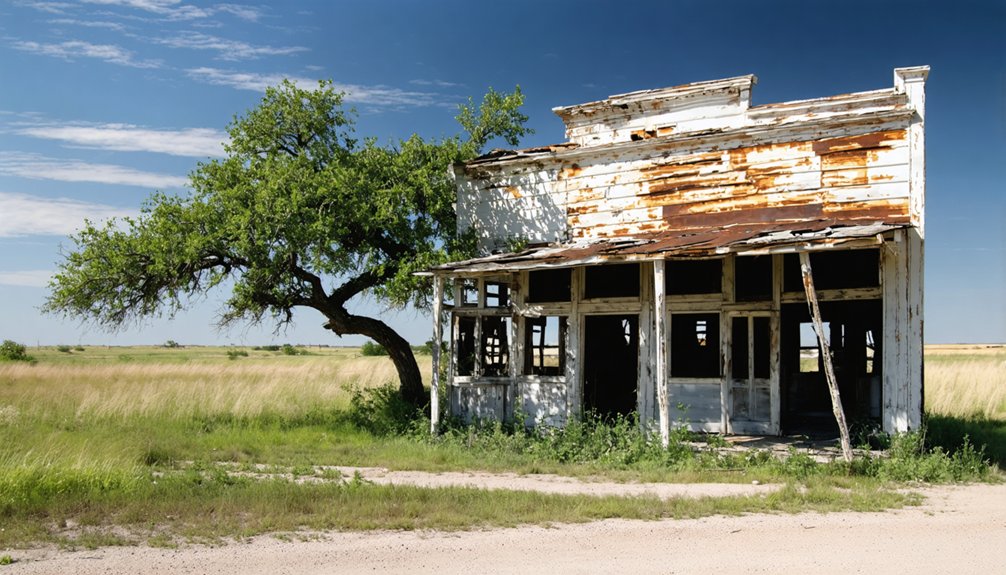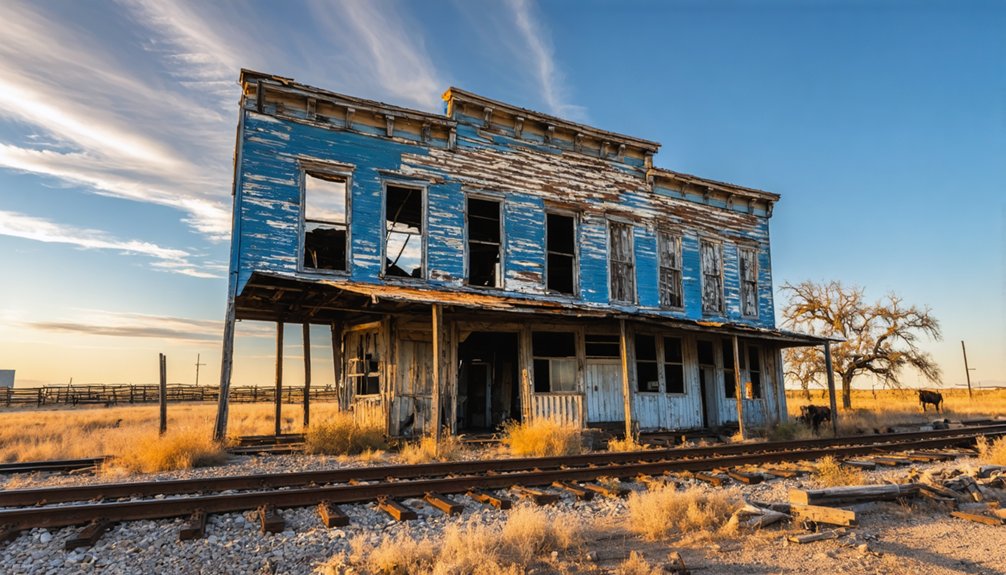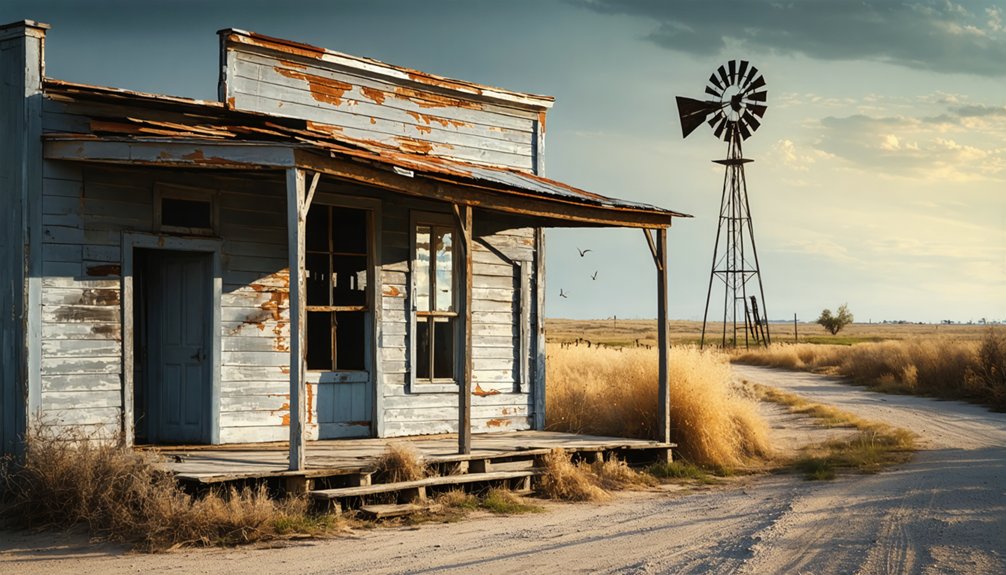You’ll find Longfellow, Texas, 24 miles east of Sanderson in Terrell County, where Southern Pacific Railroad established it in 1881. Named after poet Henry Wadsworth Longfellow, this former railroad town thrived as a crucial livestock shipping point with a bustling depot and telegraph office. After the 1944 freight office closure and 1954 water well abandonment, it transformed into a ghost town. Today, only foundations, rubble, and Victorian tombstones tell its story of railroad glory and decline.
Key Takeaways
- Longfellow was established in 1881 by Southern Pacific Railroad and named after poet Henry Wadsworth Longfellow.
- The town served as a crucial livestock shipping point and railroad depot before declining in the mid-20th century.
- After the 1944 freight office closure and 1954 water well abandonment, Longfellow transformed into a ghost town.
- Located 24 miles east of Sanderson in Terrell County, only building foundations and railroad ruins remain today.
- The site offers photography opportunities among railroad ruins, though visitors should bring essentials due to limited services.
A Railroad Town Emerges
While Mexican ranchers had already settled the area, Longfellow’s true beginnings as a town emerged in 1881 when the Southern Pacific Railroad established it as a strategic depot location.
During this period of ambitious railroad expansion across Texas, Southern Pacific named the settlement after poet Henry Wadsworth Longfellow, following their typical town development strategy. Similar to how the Texas & New Orleans railway acquired smaller lines for operational integration, this pattern of railroad development was common throughout the region.
Southern Pacific Railroad’s practice of naming Texas settlements after literary figures led to Longfellow getting its poetic moniker in 1881.
You’ll find Longfellow’s early infrastructure was purpose-built for railroad operations, featuring essential facilities like a depot, telegraph office, and water supply installations for steam locomotives.
The town quickly became a crucial livestock shipping point, where local ranchers could connect to broader markets.
As the railroad brought new opportunities, a community sprouted around these facilities, with residents relying on both freight and passenger services for their livelihoods. The town’s prosperity continued until diesel locomotives led to its eventual decline.
Life in Early Longfellow
Before the railroad’s arrival transformed Longfellow, early settlers established themselves in small farming communities near crucial water sources and trading routes. Your ancestors’ daily routines revolved around cultivating grains, hunting game, and maintaining close ties with neighboring families. The region’s abundant freshwater lakes provided vital resources for these pioneering communities.
You’d find these hardy folk living in clusters around forts and trading posts, where they’d share labor and join together for community gatherings. Much like the pioneering Burkham settlement’s arrival in 1816, these early communities served as important footholds in the region.
Life wasn’t without its challenges. You’d need to maintain constant vigilance, participating in militia duties to protect against raids. Most settlers, arriving from states like Tennessee and Missouri, operated family farms on 640-acre plots.
They’d navigate complex relationships with Mexican authorities and Native American tribes, particularly the Caddos and Hasinais, while relying on essential transportation networks like Trammel’s Trace for supplies and trade.
Mexican Ranching Heritage
As Spanish colonists pushed northward in the mid-18th century, they established a robust ranching tradition that would shape South Texas for generations to come. Under José de Escandón’s leadership in 1749, settlers from Querétaro, Nuevo León, and Coahuila brought their cattle-raising expertise to the Rio Grande region.
You’ll find that vaqueros played a vital role in developing these ranching traditions. These skilled cowboys mastered horsemanship and innovative roping techniques using braided rawhide reatas. Their specialized gear, including sombreros and chaparreras, became standard equipment. These early ranchers established long, thin strips of land called porcines along the river to ensure each property had adequate water access. The vaqueros were largely mestizo or Indian workers who served as independent contractors, owning their own horses and equipment.
Southern Pacific’s Influence
Once Southern Pacific Railroad arrived in Texas, it transformed the state’s transportation landscape through strategic expansion and acquisitions.
You’ll find that SP’s railroad expansion reached El Paso by May 1881, outpacing its rival Atchison, Topeka and Santa Fe Railway. Through its subsidiary, the Galveston, Harrisburg and San Antonio Railroad, SP created essential connections that formed the nation’s second transcontinental line.
The community impact was profound as SP’s network grew. You can trace how towns like Hallsville flourished as rail hubs, while engineering marvels like the Pecos River High Bridge revolutionized regional transportation. The railroad’s first major Texas presence began when the Houston and Texas Central started operations in 1856. The Texas Western Railroad Company initially laid groundwork for expansion when they received their charter in 1852 to build westward.
The Path to Abandonment
You’ll find Longfellow’s decline was set in motion when the Southern Pacific Railroad shifted from steam to diesel locomotives in the mid-20th century, eliminating the town’s vital role as a water stop.
The closure of the railroad’s freight office in 1944, followed by the water well facilities in 1954, triggered a devastating chain reaction of business closures and job losses throughout the community.
Without economic alternatives and facing mounting hardships, residents steadily departed the isolated town, leaving behind vacant buildings and transforming the once-bustling railroad hub into a near-ghost town. This pattern of decline echoes the fate of Plemons Crossing, where residents gradually abandoned their town after losing its position as a vital transportation hub. Much like Shafter’s fate when its silver mining operations ceased in 1942, the town’s population dwindled as its economic foundation crumbled.
Railroad Decline Impact
When diesel locomotives replaced steam engines across Texas railways in the mid-20th century, Longfellow’s fate was effectively sealed. The transportation evolution swept through the state, rendering countless railroad towns obsolete.
You’d have witnessed the dramatic shift as diesel engines required fewer maintenance stops, eliminating the need for water, coal, and service stations that had sustained communities like Longfellow.
- You can still see abandoned railroad rights-of-way cutting through the Texas landscape, silent monuments to once-thriving communities.
- Your ancestors’ cattle shipping routes disappeared as over 5,000 miles of track were abandoned, severing crucial economic lifelines.
- You’ll find empty depots and deteriorating infrastructure where railroad history once pulsed with commerce and connection.
The shift to highways and trucks completed Longfellow’s isolation, triggering population decline and eventual abandonment.
Population Exodus Timeline
The rapid unraveling of Longfellow’s population followed a clear pattern tied to the railroad’s diminishing presence.
You’ll find the town’s population dynamics shifted dramatically after 1944 when the freight and telegraph office closed, triggering the first major wave of departures. By 1954, the shutdown of the water well facilities dealt another blow to community resilience, pushing more residents to seek opportunities elsewhere.
As stores shuttered and basic services vanished, you’d have witnessed the gradual emptying of homes throughout the mid-1900s. The exodus continued until only a handful of occupied buildings remained among the abandoned railroad structures.
Today, you’ll see this pattern reflected in Longfellow’s sparse landscape, where a few inhabited homes stand as lone survivors amid the quiet ruins of its railroad past.
Economic Hardships Mount
As steam locomotives gave way to diesel engines in the mid-20th century, Longfellow’s economic foundation began to crumble irreversibly.
You’ll find that the town’s transportation evolution dealt multiple blows to its survival: the closure of freight operations in 1944, followed by the shuttering of essential water facilities in 1954. Without economic resilience or industry diversification, Longfellow couldn’t adapt to changing times.
- The once-bustling livestock shipping point fell silent as modern transport methods bypassed the town.
- Railroad-dependent businesses closed their doors, leaving empty buildings as stark reminders of prosperity lost.
- Local families who’d built their lives around the railroad were forced to seek opportunities elsewhere.
The town’s singular dependence on railroad operations proved fatal when technological progress rendered its primary function obsolete.
What Remains Today

If you visit Longfellow today, you’ll find virtually no intact structures remaining at the former railroad station site, as the area has largely reverted to undeveloped land.
You can locate the ghost town‘s approximate position using historical maps, though natural overgrowth and weathering have obscured most distinguishing features.
The most notable traces of human habitation are scattered building foundations and rubble, which offer subtle hints of the town’s railroad heritage.
Physical Structures Standing
Remnants of Longfellow’s bygone era dot the Texas landscape today, with several abandoned structures standing as silent witnesses to the town’s history.
You’ll find deteriorating shells of buildings, their roofless frames exposed to the elements, serving as historical footprints for researchers. While some original public buildings remain partially intact, they’re now marked by weathered signs and boarded windows. A handful of wooden and brick homes survive, though they’re steadily succumbing to nature’s reclaim.
- Crumbling foundations whisper stories of bustling streets where merchants once traded and families gathered
- Victorian-era tombstones stand guard in the town cemetery, preserved by descendants who refuse to let memories fade
- Rusted farm equipment and old wells remind you of the self-reliant spirit that once defined this community
Railroad Traces Remain
The once-bustling Southern Pacific Railroad left lasting imprints across Longfellow’s landscape. You’ll find abandoned railroad beds and track sections marking original routes, while old sidings and passing tracks reveal where trains once maneuvered.
Near the former depot, you can trace clear railroad grades that showcase the historical significance of this transportation hub.
Along the rail corridor, you’ll discover deteriorated water facilities from the 1950s, remnants of freight offices, and scattered section houses that once sheltered maintenance crews.
Telegraph poles and foundations still stand as silent witnesses to railroad preservation efforts. The original rail line’s influence remains evident in today’s property boundaries and road alignments, while some sections have transformed into rural access roads, maintaining their connection to Longfellow’s railroad heritage.
Historic Map Locations
Modern USGS topographic maps still mark Longfellow’s location within Pecos County’s remote desert landscape, though you’ll find few traces of its former existence.
Historic maps from 1920 provide geographic context spanning Brewster, Pecos, and Terrell counties, revealing the ghost town’s placement along transportation routes through West Texas’s untamed terrain.
- You can trace the town’s footprint through old MyTopo maps showing roads, contour lines, and seasonal watercourses that once supported this desert outpost.
- The site’s isolation in the vast Texan wilderness speaks to the pioneering spirit of those who built lives here.
- While maps mark this former railroad stop, the desert has reclaimed most signs of human settlement, leaving you free to explore its haunting emptiness.
Ghost Town Tourism Guide

Located 24 miles east of Sanderson in Terrell County, Longfellow offers ghost town enthusiasts a genuine glimpse into Texas’ railroad history through its abandoned Southern Pacific structures and weathered buildings.
You’ll find excellent ghost town photography opportunities among the railroad ruins, with winter and spring providing the most comfortable conditions for exploring.
Before visiting, prepare for minimal services as no commercial stores remain active. You’ll need water, sun protection, and a reliable 2WD vehicle to navigate the accessible roads.
Pack essentials and bring a sturdy vehicle – this remote ghost town has no stores or services for miles around.
While capturing the site’s historical preservation needs, respect private property boundaries and avoid disturbing artifacts. The off-the-beaten-path location guarantees a quiet experience away from crowds, letting you explore at your own pace.
Remember to exercise caution around deteriorating structures and plan your visit around extreme summer temperatures.
Frequently Asked Questions
What Were the Names of the Original Mexican Ranching Families in Longfellow?
You won’t find specific original Mexican ranching families documented for Longfellow’s ranching heritage, though nearby South Texas family legacies include the de la Garza, Ballí, and Hinojosa ranching dynasties.
Did Any Famous Outlaws or Notable Figures Pass Through Longfellow?
You won’t find any documented outlaw legends or notable visitors in historical records. The town’s importance centered purely on railroad operations rather than famous figures passing through.
Were There Any Schools or Churches Established in Longfellow?
In a town where tumbleweeds outnumbered people a million to one, you won’t find any documented school history or church community. Historical records show no evidence of either institution being established.
What Natural Disasters or Significant Weather Events Impacted the Town?
You’ll find no major flood events directly impacted the town, but persistent drought impacted daily life, contributing to harsh conditions and limited water availability that challenged residents through the years.
Did Native American Tribes Have Settlements or Interactions in the Longfellow Area?
Like shadows across the plains, you’ll find rich evidence of tribal interactions near Longfellow, where Lipan Apache and Comanche peoples established historical settlements and conducted raids throughout the 18th century.
References
- https://mix931fm.com/12-east-texas-ghost-towns/
- https://www.southernthing.com/ruins-in-texas-2640914879.html
- https://www.youtube.com/watch?v=fQNm9tvfAcw
- https://pastmaps.com/explore/us/texas/pecos-county/longfellow/hiking-exploration
- https://en.wikipedia.org/wiki/List_of_ghost_towns_in_Texas
- https://landingaday.wordpress.com/2016/11/12/longfellow-emerson-rosenfeld-and-tesnus-texas/
- https://www.ghosttowns.com/states/tx/longfellow.html
- https://www.texasescapes.com/TOWNS/Texas-Ghost-Towns-4-West-Texas.htm
- https://www.texasescapes.com/TOWNS/Texas_ghost_towns/Longfellow_Texas/Longfellow_Texas.htm
- http://txrrhistory.com/towers/113/113.htm



